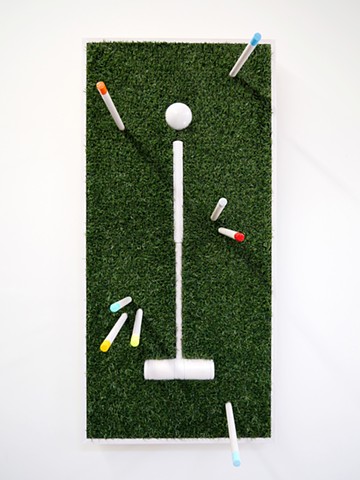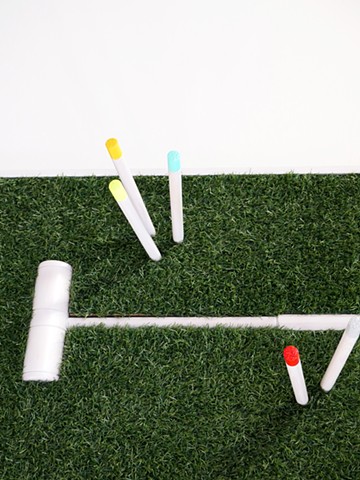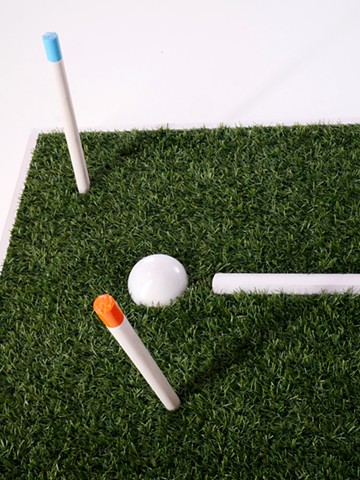Ghost Mallet: for the Watertown 8
a croquet mallet and ball set. Part of "Out of Bounds: the Art of Croquet", a group exhibition first exhibited at the Messler Gallery in Rockport Maine, then at the Center for Art in Wood, in Philadelphia, then at the Fuller Craft Museum, in Brockton Mass.
The piece makes reference to “The Watertown Eight”. This is a title that I made up, but refers to a New York Times Article from July 13, 1922. This article (Times Article) outlines a horrible tragedy from that year. * children, ranging in age (see article) were playing croquet in the yard, when one of them, they think, struck an unexploded ordinance with their mallet. The area was known to have these lying around because the local artillery battalion had been firing practice rounds, and some had been “duds”. these were left lying around the area and people would pick them up and take them home, play with them, etc. These unfortunate children found one such bit of munition and struck it. They say that the heat of the day may have made it more volatile, but for whatever reason, it exploded, killing all of them. This piece, “Ghost Mallet: for the Watertown Eight” is a type of memorial to those children. Ghost Mallet, refers to the tradition of creating “Ghost Bikes” at sites in cities at which cyclists were killed while riding. They are painted all white and chained to a signpost or tree at the location of the tragedy. Similarly, this is a memorial to someone lost doing something that brought them joy. It plays our idea of comfort and luxury off of something frightening and sinister. There are regions of the world in which unexploded mines and other ordnance are a part of everyday life. To this day landmines from the Vietnam war claim the occasional life. This is seemingly one of the longer lasting, and somehow acceptable, risks of war and military culture. This piece pays homage as a memorial to these lives lost, as well as being a functional set. It is intentionally very simple: a plain, unadorned mallet that allows for remembrance as well as gameplay. We must never forget the tragedy that is wrapped up in even our most beloved objects and pastimes. Croquet comes out of a history of the most brutal colonialism, and then becomes the most banal and lighthearted of lawn games. The things that bring us these simple pleasures contain multitudes. Our joy is complex and so often makes its way to us at great cost. This set memorializes a tragic event and those lost in it, while holding aloft the object that brings us such pure joy. To play, to surround ourselves with friends, to laugh and dig our toes into the grass, to spend an entire afternoon pushing a ball around a yard: these things are treasures.


